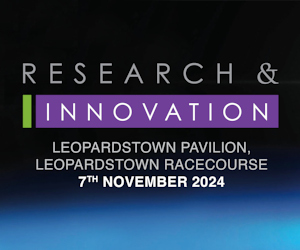New Research to Improve Environmental Sustainability Commences

Improving environmental sustainability of modern-day agricultural production systems, especially in relation to climate change, is the focus of new research. Methane, a potent greenhouse gas, is produced by micro-organisms in the gut of ruminants such as cattle and sheep. While altering farm management practices has considerable mitigation potential, there is also massive potential at the level of the individual animal to improve both economic and environmental sustainability.
Director of the VistaMilk SFI Research Centre, Donagh Berry, Teagasc, said: “Ireland now boasts equipment to measure methane emissions on sheep, cattle and grazing dairy cows. The available equipment can be used to evaluate breeding and management strategies to reduce animal-level methane emissions.”
While total national greenhouse gas output is the metric from which Ireland will be judged, it is the efficiency of producing human edible energy and protein per unit carbon dioxide equivalent which is generally the focus among researchers. Being able to reduce the daily methane output from animals is advantageous, but lower hanging fruit does exist without the necessity to measure methane. In dairying, this low hanging fruit is based on producing greater lifetime milk solids and beef through calving for the first time at 24 months of age and producing high milk solids yield off grazed grass for 5.5 lactations.
Teagasc researcher Donal O’Brien has demonstrated a reduction of 14% in carbon dioxide equivalents per kilogram of milk solids produced by the modern Irish dairy cow relative to the dairy cow at the turn of the century. Complementing greater mature female longevity in beef and sheep, is the ability to shorten age at slaughter off predominantly grazed grass without compromising carcass credentials. “Our data consistently shows that beef cattle in the top 20% genetically are, on average, slaughtered 80 days younger than those in the bottom 20% for the same carcass weight; the genetically elite animals also have far superior carcass conformation,” said Teagasc beef geneticist, Noirin McHugh.
Through funding from the Department of Agriculture, Food and Marine’s (DAFM), GREENBREED project, four new machines to measure methane production per animal have been installed at the national performance test station operated by the Irish Cattle Breeding Federation (ICBF); this is in addition to the two already in place. Up to 600 growing cattle will be measured annually for methane production with the view of producing national genetic evaluations for this new trait.
The VistaMilk SFI Research Centre has recently invested in the first systems in Ireland to measure methane production at grass. The lead VistaMilk technician, Katie Starsmore said: “These systems will be used to evaluate the effectiveness of alternative complementary feeds in reducing methane production, with the results to-date of these complementary feeds from confinement production systems, being very positive. In addition, through the co-located Food Research Centre at Moorepark, Teagasc are uniquely positioned to not only evaluate the effect of the feed in reducing methane emissions but also to assess any potential impact that the complementary feeds may have on milk processing and sensory properties of the milk.” The data generated will also be used in an SFI Starter Investigator Research Grant lead by Teagasc’s Sinead McParland to evaluate the ability of infrared spectroscopic analysis of milk to predict methane production in dairy cows; the goal is to generate estimates of individual cow genetic merit for methane production.
Research has just started on measuring methane emissions in sheep using what are called Portable Accumulation Chambers. Methane production will be firstly measured on lambs participating in the INZAC trial at Teagasc Athenry which is evaluating alternative Irish and New Zealand genotypes. Recently started GREENBREED technician Eoin Dunne said; “Our plan is, through collaboration with our colleagues in the Agri-Food and Bioscience Institute in Northern Ireland, to validate our portable accumulation chambers against the gold standard calorimeters. If successful, then the mobile units can be transported to informative flocks to collect data for a national breeding programme.”
While focus remains on improving all efficiencies at farm level and, by extension, output per unit carbon dioxide equivalent, large on-going projects are also investigating complementary strategies to reduce daily methane emissions in our cattle and sheep populations.
The VistaMilk SFI Research Centre is funded by Science Foundation Ireland (SFI) and DAFM and represents a unique collaboration between Agri-Food and information communications technology (ICT) research institutes and leading Irish/multinational food and ICT companies.
CAPTION:
The VistaMilk SFI Research Centre has recently invested in the first systems in Ireland to measure methane production at grass. The lead VistaMilk technician, Katie Starsmore Katie Starsmore pictured setting up the recently purchased Greenfeed system located in Teagasc Moorepark, the first Greenfeed systems in Ireland for measuring methane outdoors.







